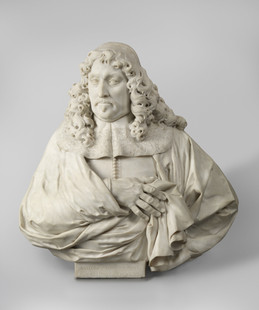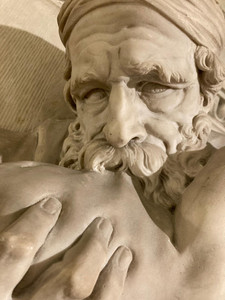Amsterdam in Marble: Artus Quellinus Expo at Royal Palace (18 June – 27 Oct)
- Fernanda Matsuoka

- Jun 19
- 4 min read
Updated: Jun 26

As Amsterdam marks its 750th anniversary, the city turns its gaze not only to its painters and merchants, but to the man who sculpted its identity in marble: Artus Quellinus. From 18 June to 27 October, Artus Quellinus – Sculptor of Amsterdam takes center stage in a landmark joint exhibition between the Royal Palace Amsterdam and the Rijksmuseum. A long-overdue tribute to a Flemish sculptor who helped define the visual language of the Dutch Golden Age, the exhibition is both a deep dive into 17th-century Baroque sculpture and a meditation on permanence in an ever-evolving city.
THE EXPO IN A NUTSHELL
Artus Quellinus – Sculptor of Amsterdam runs from 18 June to 27 October 2025, jointly presented by the Royal Palace Amsterdam and the Rijksmuseum. Featuring over 100 works from national and international collections—including sculptures in marble, terracotta, ivory, and wood—this is the first full retrospective dedicated to Quellinus.
The exhibition is housed within the Royal Palace Amsterdam—a rare treat in itself—as well as the Rijksmuseum’s sculpture galleries. Together, these two venues offer a layered experience that links history, artistry, and urban identity. Many pieces have never been shown in the Netherlands before.

From Antwerp to Amsterdam: The Rise of a Master

Artus Quellinus (1609–1668) was born in Antwerp and trained in the classical traditions of Rome before making his mark north of the border. When he arrived in Amsterdam in the 1650s, the city was at the height of its civic ambitions. The construction of the new Town Hall on Dam Square—now the Royal Palace—was meant to be a symbol of the Dutch Republic’s wealth, stability, and enlightened governance. And it needed an artist with gravitas.
Quellinus answered the call, bringing a Southern Baroque flourish to the more restrained Northern aesthetic. What followed was a two-decade-long commission that transformed the Town Hall into a marble epic, where gods, virtues, and civic allegories emerged from stone with astonishing vitality. His signature pieces—like the imposing Atlas carrying the heavens and the intricate reliefs of the Vierschaar (Tribunal)—weren’t just decorative; they were ideological, offering a sculpted vision of justice, power, and civic pride.
He was honored, fittingly, with the title Sculptor of Amsterdam.
The Baroque Comes North
Quellinus was a key figure in bringing the Baroque movement to the Dutch Republic. Influenced by Peter Paul Rubens and Italian classicism, Baroque art emphasized theatricality, rich detail, and emotional intensity. Yet in the Protestant north—where visual art was often more restrained—Quellinus translated the exuberance of the Southern Baroque into civic architecture, imbuing Amsterdam’s secular spaces with classical grandeur. His sculptures were not only expressions of style, but also tools of persuasion: embodying virtue, order, and the power of the young republic.
His work helped shape a distinctly Dutch iteration of Baroque art—rooted in allegory, rationality, and humanism—making him an essential, if often overlooked, bridge between Southern Catholic and Northern Protestant aesthetics.
A First-of-Its-Kind Retrospective

Despite his profound influence, Quellinus has remained curiously under-recognized in mainstream art history. This exhibition sets out to change that. More than 100 works—many never before exhibited in the Netherlands—have been gathered from museums, churches, and private collections across Europe. From intimate ivory carvings to monumental marbles, the range is staggering. Highlights include the expressive Saint Peter from the Church of St. Andrew in Antwerp, the striking Pallas Athena from Museum Kurhaus Kleve, and a powerful marble portrait of the Amsterdam regent Andries de Graeff.
For those already familiar with Quellinus’s work in the Royal Palace, the Rijksmuseum provides critical context. Sixty pieces from its collection—including terracotta models, sketches, and technical studies—reveal his creative process, his workshop practices, and the intellectual depth behind each commission.
Where to See His Work Today
Quellinus’s legacy is still tangible across Amsterdam and beyond. His most iconic works are found at the Royal Palace Amsterdam—formerly the Town Hall—including the Atlas on the pediment, the allegorical sculptures in the Burgerzaal (Civic Hall), and the reliefs in the Vierschaar courtroom. The Rijksmuseum holds an exceptional collection of his models and portrait busts, many of which are included in this exhibition.
Further afield, you’ll find his religious commissions in Belgium—most notably the Saint Peter in Antwerp’s St. Andrew’s Church—and civic monuments in cities such as The Hague, Middelburg, and Ghent. Several of his family members, including his brother and nephew, were also accomplished sculptors, often working in a shared workshop tradition that extended Quellinus’s influence well into the next generation.
A Dialogue Between Institutions—and Centuries
This collaboration is as symbolic as it is scholarly. The Royal Palace represents Quellinus’s largest surviving body of work, the very stone canvas on which his genius was realized. The Rijksmuseum, meanwhile, has long preserved the fragile models and drawings that informed his grand commissions. Together, they offer a complete narrative—from conception to execution—of one of the 17th century’s most visionary sculptors.
And it’s not just an exhibition; it’s a research project. Years of art historical and technical study underpin this presentation, culminating in a richly illustrated publication from the Rijksmuseum that delves into Quellinus’s legacy with fresh academic insight.
—
At Sapiens Travel, we don’t just show you the city—we introduce you to the minds that made it. Reach out to our team to weave the Quellinus exhibition into your cultural journeys through the Netherlands this summer and fall.





















